Clematis is one of the most admired climbing plants, celebrated for its striking flowers, wide range of colors, and long blooming season. With so many types of clematis plants available, gardeners can choose compact varieties for pots, vigorous climbers for walls and fences, or delicate species for natural garden designs. Each type adds unique beauty, making clematis a versatile choice for any landscape.
This guide introduces 42 types of clematis plants with pictures and identification tips. From early-blooming alpine species to large-flowered hybrids and late-summer performers, these varieties offer diverse shapes, colors, and growth habits. Learning about their unique features will help you select the best clematis for your garden.
These types of clematis plants include vivid reds, soft pastels, double-flowered forms, and even fragrant options. Along with identification, you will find information about their blooming periods, care tips, and USDA growing zones to help you grow healthy, vibrant clematis throughout the season.
Different Types of Clematis Plants
Jackmanii
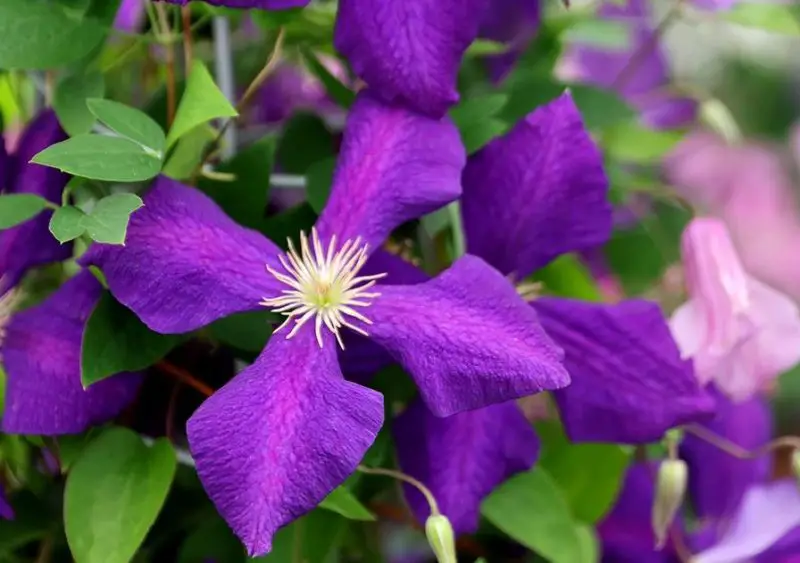
The Jackmanii clematis is one of the most popular and widely grown varieties, known for its vigorous growth and striking purple flowers. Its blooms are typically 4 to 6 inches wide, featuring velvety, rich violet-purple petals with a slightly darker center bar and contrasting yellow stamens. This deciduous climber can grow up to 10 to 12 feet tall, making it an excellent choice for covering trellises, fences, and arbors. Its flowers appear abundantly from early summer to early fall, providing a long season of color in the garden.
Identifying the Jackmanii is easy due to its vibrant, four- to six-petaled star-shaped blooms and lush green foliage. The flowers often have a slightly crinkled texture, adding to their unique appeal. It is a member of the large-flowered clematis group and is prized for its reliability and ability to rebloom after pruning. The plant produces an impressive display when trained on vertical supports, and its deep color stands out beautifully against lighter backgrounds.
Caring for Jackmanii involves planting it in well-draining soil enriched with organic matter and ensuring it receives full sun to partial shade. Like most clematis, its roots prefer to stay cool, so mulching or planting low-growing perennials around its base is recommended. Pruning should be done in late winter or early spring, cutting back to strong buds to encourage new growth and abundant blooms. It thrives in USDA hardiness zones 4 through 8.
The President
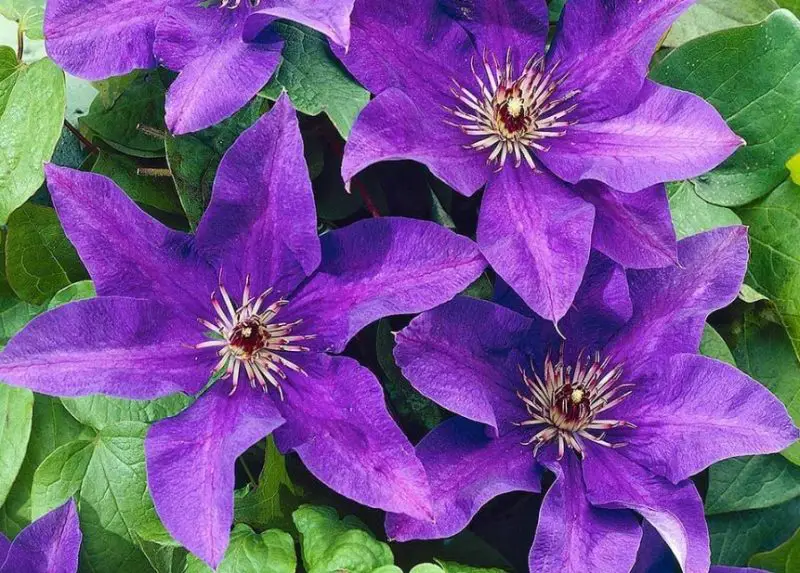
The President clematis is a beloved classic, admired for its large, vibrant blue-purple flowers. Its blooms measure 6 to 8 inches across, featuring overlapping petals with a slightly ruffled edge and prominent reddish stamens. This variety is a vigorous climber, typically reaching 8 to 10 feet in height, making it ideal for walls, pergolas, and garden trellises. It produces flowers in late spring to early summer and often has a second flush of blooms later in the season.
Identification of The President is easy thanks to its distinctive deep blue-violet petals, which can appear almost metallic in bright sunlight. The flowers have a velvety texture, and their striking contrast against the dark green foliage makes them highly ornamental. This variety is particularly valued by gardeners looking to add dramatic color to vertical spaces, and its blooms are long-lasting, making it suitable for cut flower arrangements.
For care, plant The President in fertile, well-drained soil with consistent moisture. It prefers full sun for maximum flower production but can tolerate partial shade, especially in hotter climates. Pruning should follow the Group 2 clematis guidelines, which involve light trimming after the first bloom and more substantial cutting back in late winter. It grows best in USDA hardiness zones 4 through 8.
Nelly Moser
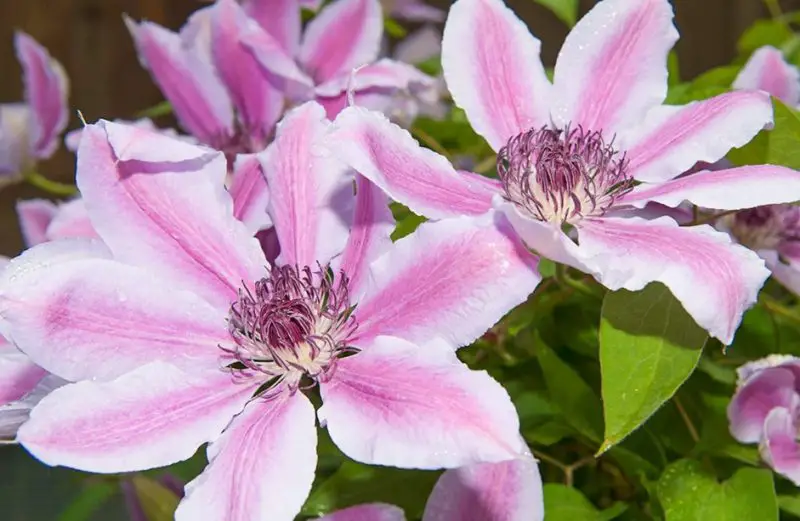
The Nelly Moser clematis is renowned for its delicate beauty, featuring soft pinkish-lavender flowers with a striking deep pink stripe running through each petal. The blooms are large, usually 6 to 8 inches wide, and have a slightly ruffled edge with creamy-yellow stamens at the center. This deciduous climber grows 6 to 10 feet tall and is perfect for garden walls, fences, or trellises. Its primary bloom period is in late spring to early summer, with occasional repeat flowering in early fall.
Easily identified by its distinctive striped petals, Nelly Moser is a favorite among gardeners seeking a softer, romantic color palette. The flowers have a star-like shape and look particularly beautiful in shaded or partially shaded areas, where the colors remain vibrant and less prone to fading. Its contrasting foliage and light blooms make it a standout feature in cottage and woodland gardens.
Nelly Moser thrives in well-drained, fertile soil with regular watering to keep the soil consistently moist but not waterlogged. It prefers partial shade, especially in regions with strong sunlight, as its pastel-colored blooms can bleach in intense heat. Following Group 2 pruning, trim lightly after the first bloom and cut back in late winter to encourage strong growth. This variety grows well in USDA hardiness zones 4 through 8.
Princess Diana
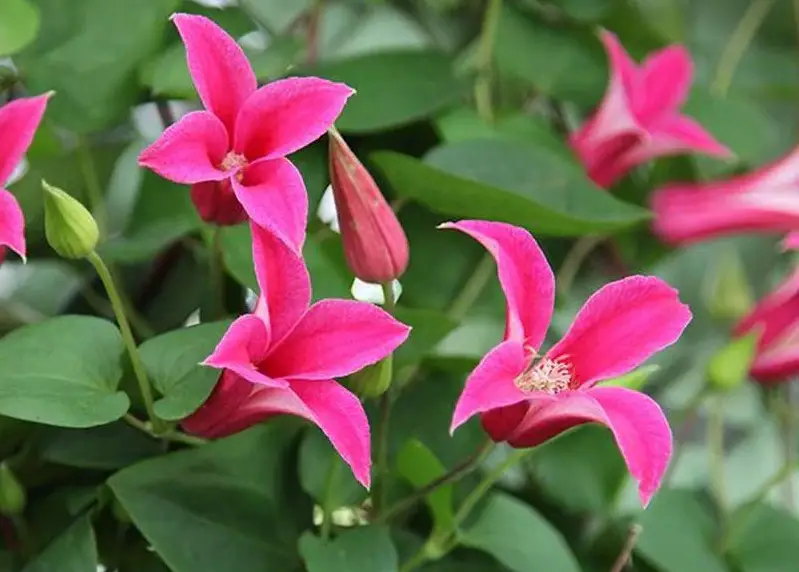
Princess Diana clematis is a charming variety with distinctive tulip-shaped flowers, a unique feature among clematis. The blooms are a bright, rosy-pink color with slightly recurved petals and creamy-yellow stamens, measuring about 2 to 3 inches long. It is a moderately vigorous climber, reaching 6 to 8 feet in height, and blooms profusely from midsummer to early fall, making it a reliable choice for extended garden color.
Its identification is simple due to its unusual flower shape, which resembles small tulips rather than the typical flat star-shaped clematis blooms. The bright pink flowers contrast beautifully with the lush green foliage, making it ideal for adding a cheerful and elegant look to fences, trellises, or containers. Princess Diana also pairs well with other clematis varieties for a layered floral display.
For optimal growth, plant Princess Diana in well-drained, fertile soil in a sunny to partially shaded location. It prefers consistent moisture but should not be overwatered. Pruning follows Group 3 clematis rules, meaning it can be cut back hard in late winter or early spring to encourage vigorous new growth and abundant flowering. It grows best in USDA hardiness zones 4 through 9.
Comtesse de Bouchaud
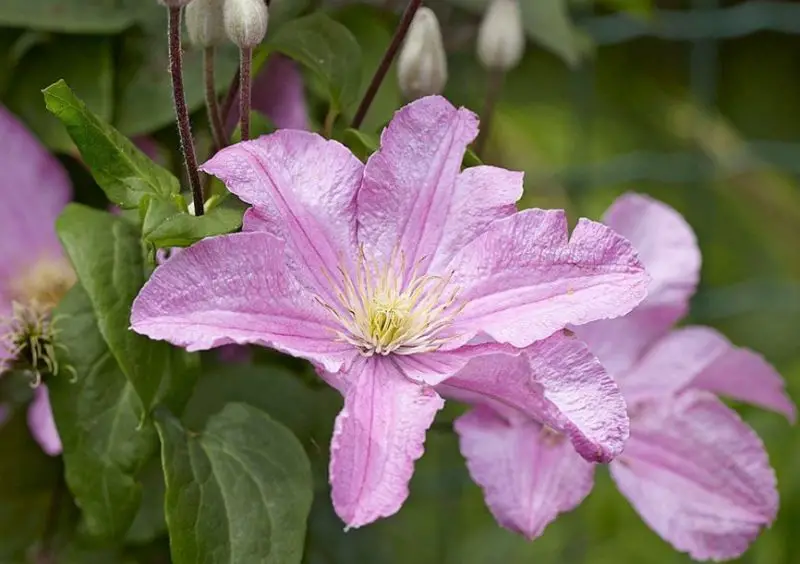
The Comtesse de Bouchaud clematis is celebrated for its profusion of rosy-pink flowers, which are slightly rounded with a soft, velvety texture. Each bloom measures around 4 to 6 inches in diameter and features yellow stamens, creating a warm, romantic effect. This vigorous climber reaches 8 to 10 feet tall and blooms abundantly from midsummer through early fall, offering a long-lasting display of color.
Identifying Comtesse de Bouchaud is easy due to its soft pink coloring, which sometimes fades to a lighter shade as the flowers mature. The petals are slightly wavy, and the overall plant has a bushy, lush appearance. It is a favorite choice for garden trellises, walls, and pergolas, where its pastel flowers create a charming cottage-garden look.
Caring for Comtesse de Bouchaud is straightforward. Plant it in rich, well-draining soil and ensure it receives full sun to partial shade for optimal blooming. Mulching helps keep the roots cool, which clematis prefer. This variety belongs to the Group 3 pruning category, so it should be cut back to about 12 inches in late winter or early spring to encourage strong new shoots. It thrives in USDA hardiness zones 4 through 9.
Étoile Violette
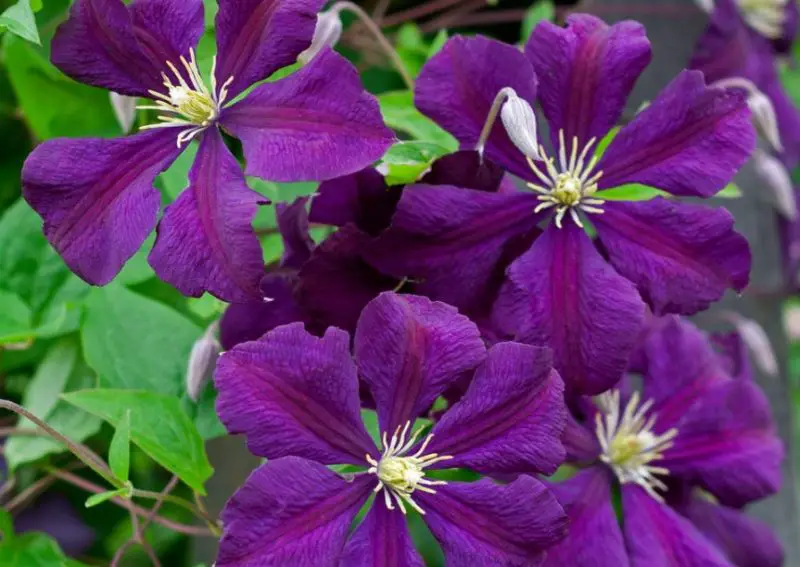
Étoile Violette clematis is admired for its rich, velvety purple flowers that bring a dramatic touch to the garden. The blooms are usually 3 to 4 inches in diameter, featuring four to six slightly rounded petals with a soft texture and contrasting creamy-yellow stamens. This vigorous climber can grow 10 to 12 feet tall, making it ideal for covering pergolas, trellises, and walls. Its flowering period extends from mid-summer to early fall, ensuring months of striking color.
Identifying Étoile Violette is straightforward due to its deep purple, almost plum-colored flowers and lush green foliage. The petals sometimes have a slightly lighter edge, adding depth to their appearance. Known for its abundant flowering, this variety creates a spectacular display when allowed to scramble over arbors or blend with other climbing plants, particularly light-colored roses.
Caring for Étoile Violette involves planting it in fertile, well-drained soil with regular watering to keep the roots cool and moist. It thrives in full sun to partial shade, where its flower color remains rich and vibrant. As a Group 3 clematis, it benefits from hard pruning in late winter or early spring, cutting back to about 12 inches to encourage fresh, vigorous growth. It performs best in USDA hardiness zones 4 through 9.
Freckles
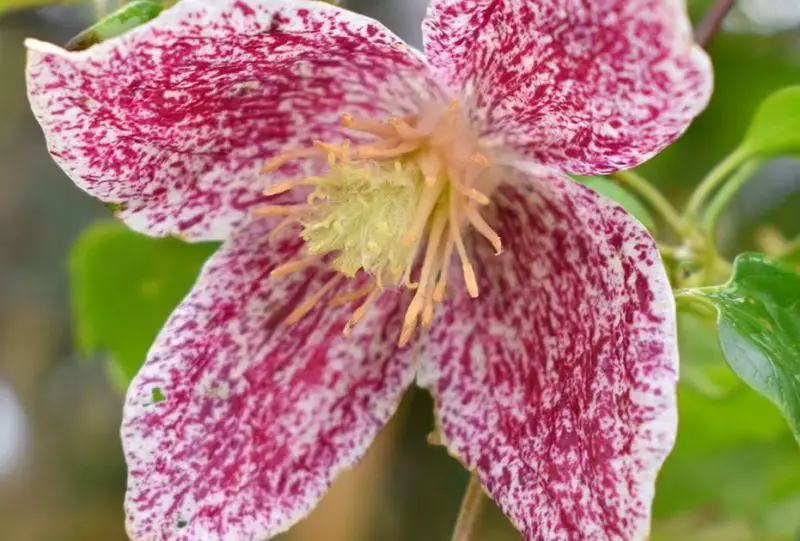
Freckles clematis is a charming winter-flowering variety, prized for its unusual nodding, bell-shaped blooms. Each flower is creamy-pink with deep reddish-purple speckles, creating a delicate, freckled appearance, hence its name. The blooms are smaller, about 1 to 2 inches wide, but they appear in profusion from late autumn through early spring, providing valuable winter color when few other plants are in bloom.
This variety is easily identified by its downward-facing, cup-shaped flowers and evergreen to semi-evergreen foliage. The plant typically reaches 6 to 10 feet in height, making it ideal for training on trellises, archways, or even over shrubs. Its unique flowering season and speckled petals make it a standout feature in winter gardens, especially when paired with other cold-weather bloomers.
For best growth, plant Freckles in well-drained soil enriched with organic matter. It thrives in full sun to partial shade but prefers sheltered spots to protect its winter flowers from harsh weather. Regular watering is important, particularly in dry periods, to maintain healthy foliage. As a Group 1 clematis, pruning is minimal—only light trimming after flowering is needed. It grows well in USDA hardiness zones 7 through 9.
Henryi
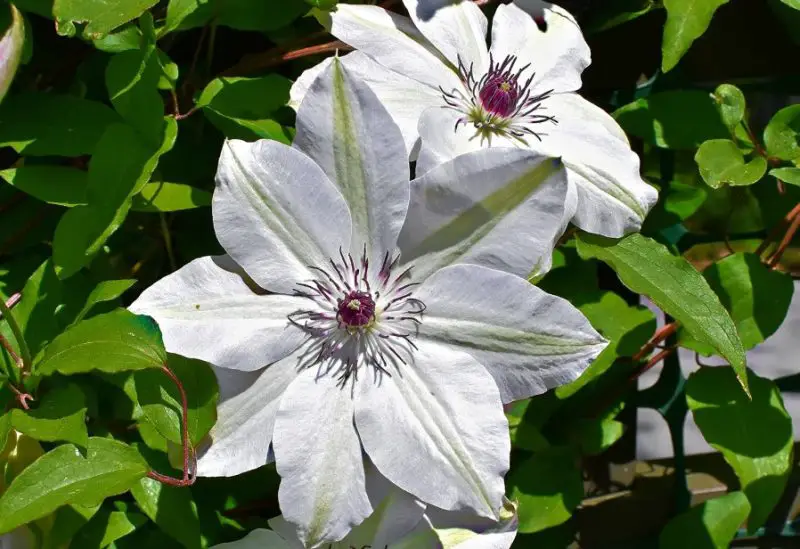
Henryi clematis is a classic, elegant variety known for its large, creamy-white flowers that brighten any garden. The blooms are 6 to 8 inches wide, with slightly overlapping petals and a satin-like texture, complemented by golden-yellow stamens at the center. This vigorous climber reaches 8 to 10 feet in height and flowers profusely from late spring to early summer, with a second flush of blooms often appearing in late summer.
Identifying Henryi is simple due to its pure white flowers, which sometimes have a faint greenish tinge along the midrib. The star-shaped blooms stand out beautifully against the deep green foliage, making it an excellent choice for creating a crisp, clean contrast in garden borders or climbing over pergolas and fences. It is a popular choice for classic and formal garden designs.
Henryi prefers fertile, well-drained soil and grows best in full sun to partial shade. It benefits from consistent watering, especially during dry spells, and mulching helps keep its roots cool. Following Group 2 pruning, it requires light trimming after its first flowering and more substantial cutting back in late winter. It thrives in USDA hardiness zones 4 through 8.
General Sikorski
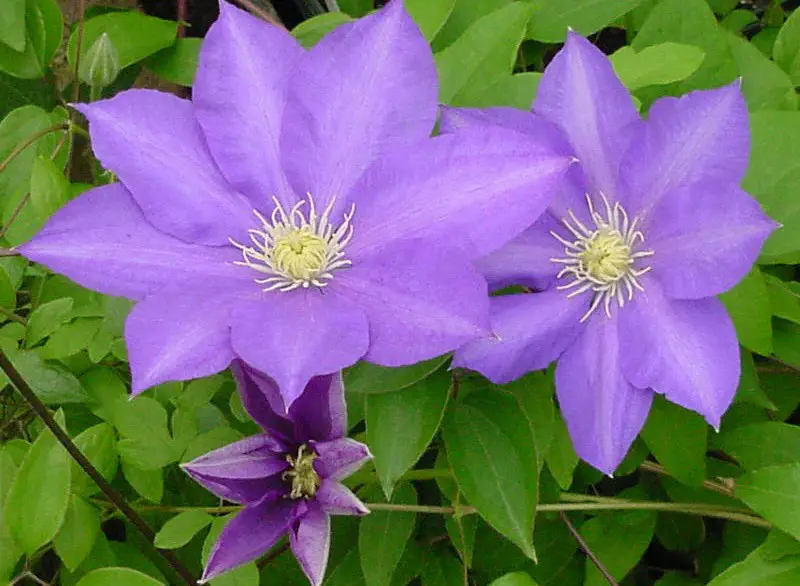
General Sikorski clematis is admired for its rich, violet-blue flowers with a hint of mauve, creating a luxurious and refined look. The blooms are 6 to 8 inches across, with slightly ruffled edges and contrasting yellow stamens, providing a striking display. It grows 8 to 10 feet tall and flowers mainly in late spring to early summer, with a repeat flush often appearing in late summer or early fall.
Easily recognized by its rich, velvety blue-purple petals, General Sikorski adds a regal touch to trellises, fences, and garden walls. The color appears more intense in partial shade, making it a good choice for spots with dappled sunlight. The plant pairs beautifully with lighter-colored roses or other pale clematis for a layered, sophisticated effect.
For optimal care, plant General Sikorski in fertile, well-draining soil with consistent moisture. It thrives in full sun to partial shade and prefers its roots to stay cool, so mulching or companion planting is recommended. As a Group 2 clematis, it needs light pruning after the first flush of flowers and harder pruning in late winter or early spring. It grows well in USDA hardiness zones 4 through 8.
Bees’ Jubilee
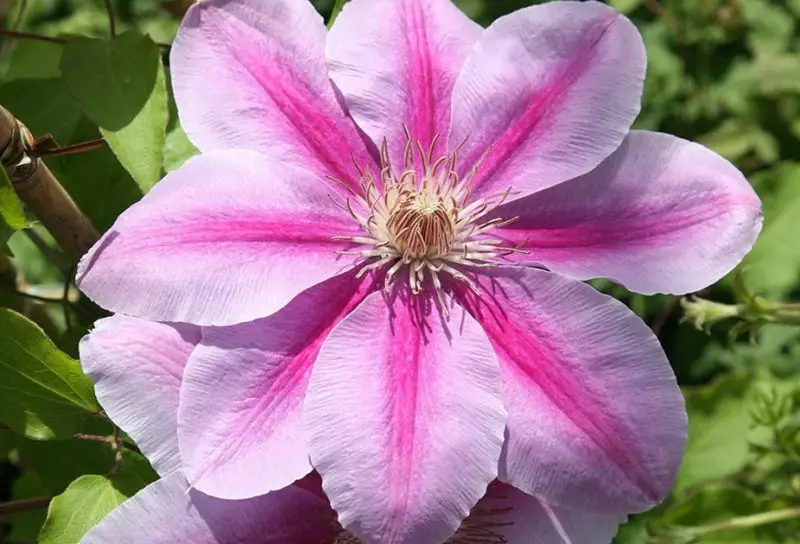
Bees’ Jubilee clematis is a delightful variety featuring large, pale pink flowers with a bold, deep pink stripe down the center of each petal. The blooms measure 6 to 8 inches across, with rounded petals and yellow stamens, giving them a cheerful, eye-catching appearance. This climber reaches 6 to 8 feet in height and flowers mainly in late spring to early summer, with a lighter second bloom in late summer.
Identifying Bees’ Jubilee is easy due to its striking striped petals, which create a vibrant contrast against its dark green foliage. The soft pastel tones make it ideal for cottage gardens, and it looks stunning climbing over fences, arbors, or garden trellises. Its compact size also makes it suitable for container gardening.
Bees’ Jubilee thrives in fertile, well-drained soil and prefers full sun to partial shade. It should be watered regularly, especially during dry periods, to keep the soil consistently moist. Light pruning after the first flowering encourages repeat blooms, while harder pruning in late winter follows Group 2 clematis guidelines. It performs well in USDA hardiness zones 4 through 8.
Josephine (Evijohill)
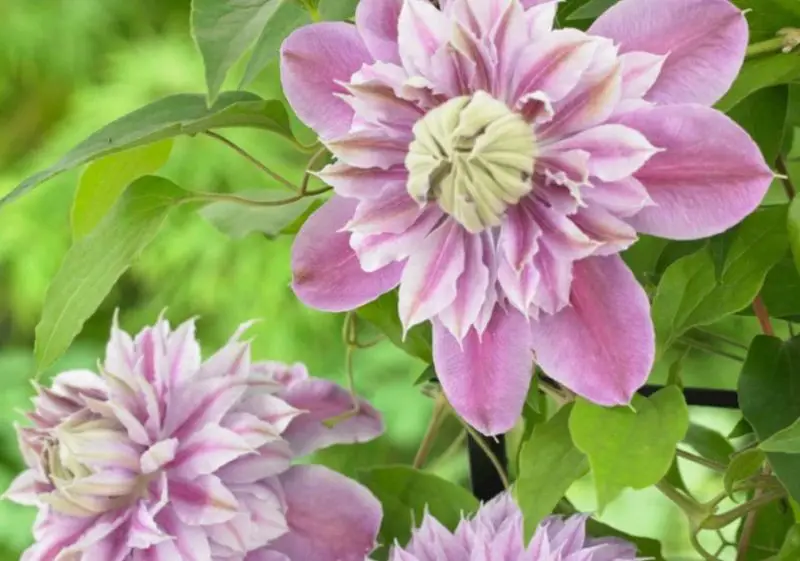
Josephine (Evijohill) clematis is a show-stopping variety known for its large, fully double flowers that look almost like dahlias. The blooms are 4 to 6 inches wide, featuring soft mauve-pink outer petals and ruffled, frilly centers in shades of pink and cream. It flowers mainly in late spring to early summer, with a lighter second flush in late summer, making it a long-lasting beauty in the garden. The plant grows to about 6 to 8 feet tall, making it ideal for smaller trellises, fences, or containers.
Identification of Josephine is unmistakable due to its unique double blooms, which have a rosette-like shape that stands out among other clematis varieties. The flowers gradually open, revealing layers of frilled inner petals that give them a rich, textured appearance. Its romantic color and unusual form make it a favorite for cottage gardens and ornamental displays.
Caring for Josephine requires fertile, well-drained soil and consistent moisture to keep the roots cool. It thrives in full sun to partial shade but benefits from some protection from intense afternoon sunlight to prevent fading. Following Group 2 pruning, light trimming after the first flush helps encourage reblooming, while more substantial pruning should be done in late winter. This variety performs best in USDA hardiness zones 4 through 9.
Ville de Lyon
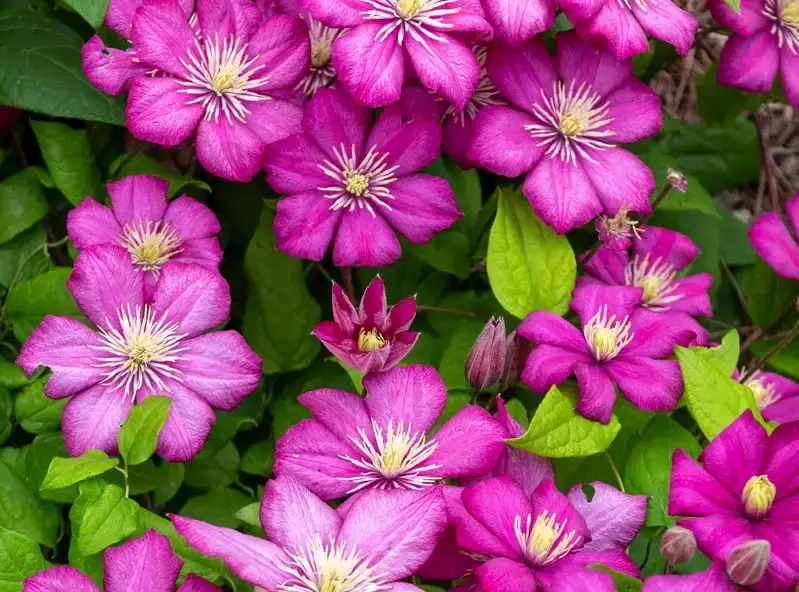
Ville de Lyon clematis is an old, reliable favorite, loved for its vibrant carmine-red to magenta flowers. The blooms are 4 to 6 inches across, with velvety petals and a slightly lighter edge, complemented by golden-yellow stamens. This vigorous climber can grow 10 to 12 feet tall, making it perfect for covering walls, pergolas, and tall trellises. It blooms profusely from mid-summer to early fall, providing a bold splash of color.
Identifying Ville de Lyon is easy due to its intense reddish-pink flowers that fade slightly as they age, giving the plant a multicolored effect during its peak blooming season. Its strong growth and prolific flowering habit make it one of the most dependable clematis varieties for adding vibrant color to the garden. It pairs well with pale roses or white-flowering clematis for a striking contrast.
For care, plant Ville de Lyon in rich, well-draining soil with regular watering to keep the roots consistently moist. It prefers full sun to partial shade, although some shade during the hottest part of the day will help preserve its flower color. Pruning follows Group 3 clematis guidelines, requiring a hard cutback in late winter or early spring to encourage strong new growth. It thrives in USDA hardiness zones 4 through 9.
Duchess of Edinburgh
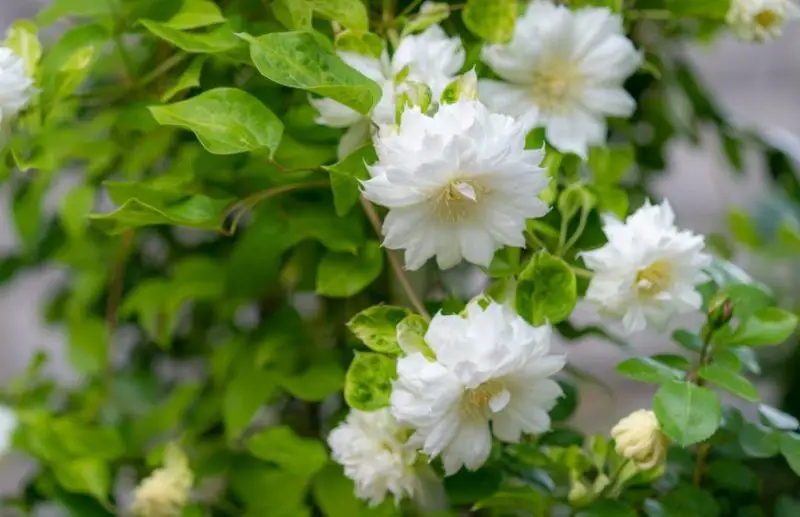
The Duchess of Edinburgh clematis is a luxurious double-flowered variety, prized for its elegant, pure white blooms. The flowers are 4 to 6 inches across, featuring multiple layers of ruffled petals and soft yellow stamens at the center. This climber typically grows 8 to 10 feet tall and produces its primary flush of flowers in late spring to early summer, with additional blooms appearing sporadically in late summer.
Identification is easy due to its exquisite double blooms, which have a slightly creamy hue when newly opened, maturing to a crisp white. The romantic and refined flowers make it an excellent choice for classic gardens, where it can climb over arbors, trellises, or be used to brighten shaded areas with its luminous color.
The Duchess of Edinburgh thrives in fertile, well-drained soil and prefers a location with full sun to partial shade. Regular watering is important to maintain healthy growth, and mulching will help keep the roots cool. As a Group 2 clematis, light pruning after the first flowering helps encourage reblooming, while harder pruning should be done in late winter. It grows best in USDA hardiness zones 4 through 8.
Constance
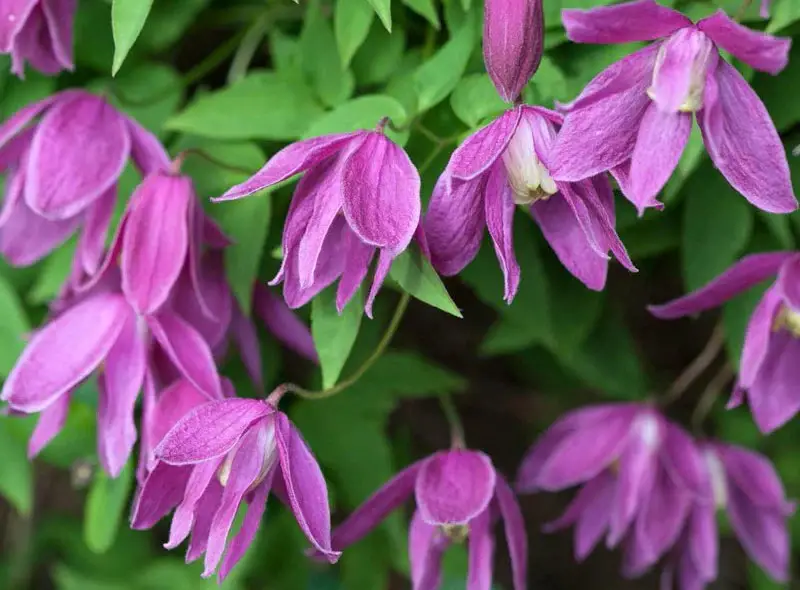
Constance clematis is a delightful early-flowering variety, celebrated for its soft, bell-shaped pink flowers. The blooms are usually 2 to 3 inches wide, with a deeper pink hue at the base and paler tips, creating a soft gradient effect. This vigorous climber reaches 10 to 15 feet tall, making it ideal for walls, fences, or scrambling through shrubs. It flowers abundantly from late spring to early summer, providing early-season garden color.
Identifying Constance is easy thanks to its nodding, bell-shaped blooms, which give it a natural, woodland charm. The flowers hang gracefully from the stems, contrasting beautifully with its divided green leaves. Its soft, romantic look makes it perfect for cottage gardens and naturalistic landscapes.
For best growth, plant Constance in moist, well-drained soil with plenty of organic matter. It prefers full sun to partial shade, thriving particularly well in cooler climates. Minimal pruning is required as it belongs to Group 1 clematis—only light trimming after flowering is necessary to maintain its shape. This variety performs best in USDA hardiness zones 6 through 9.
Frankie
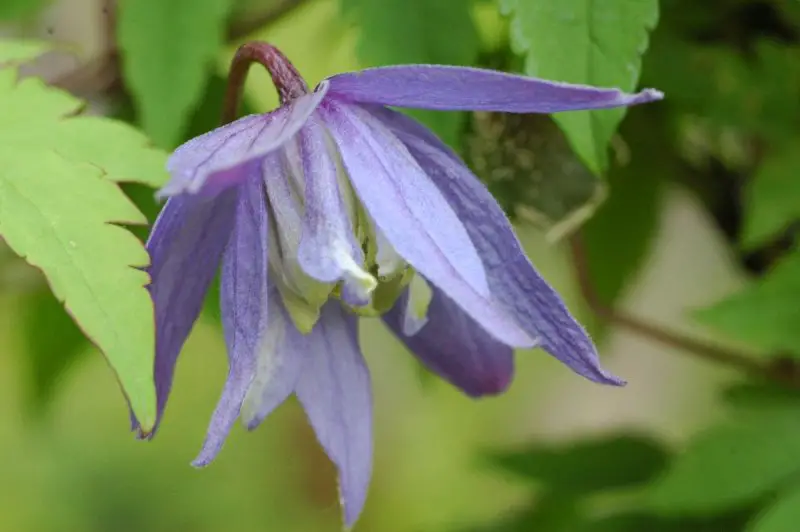
Frankie clematis is a charming compact variety, perfect for smaller gardens or container growing. It features masses of small, star-shaped flowers in a delicate lavender-blue shade with contrasting creamy-yellow stamens. Each bloom measures about 2 to 3 inches across, appearing abundantly from late spring through early summer, with occasional reblooming later in the season. It typically grows 5 to 7 feet tall, making it suitable for patios and small trellises.
Identification is easy due to its profuse, small, lavender-blue flowers that cover the plant almost entirely during peak bloom. The blooms have a slightly crinkled texture, and their pastel tones add a soft, airy charm to garden borders or balcony displays. Its compact growth habit makes it a favorite among gardeners with limited space.
Caring for Frankie is simple—it thrives in fertile, well-drained soil with regular watering to keep the soil moist but not waterlogged. It prefers full sun to partial shade, with some afternoon shade recommended in hotter climates. Following Group 2 pruning, light trimming after the first flush of flowers encourages more blooms later in the season. Frankie grows well in USDA hardiness zones 4 through 9.
Super Nova
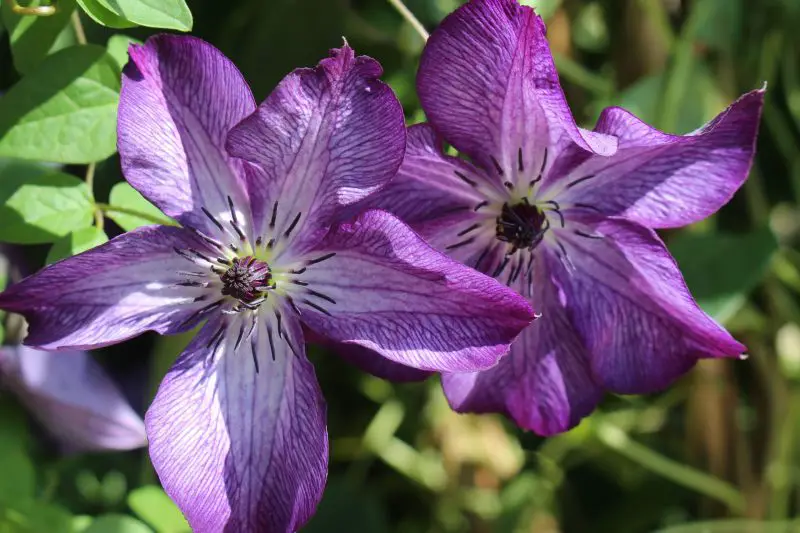
Super Nova clematis is a spectacular variety celebrated for its large, star-shaped flowers in shades of rich purple with slightly darker veining. Each bloom measures 5 to 7 inches across, featuring velvety petals with a smooth texture and contrasting creamy-yellow stamens. This compact yet vigorous climber grows to about 6 to 8 feet tall and produces an impressive flush of blooms from late spring through early summer, with repeat flowering often occurring in late summer.
Identifying Super Nova is easy due to its bold, deep purple petals that maintain their rich color even in full sunlight. The flowers have a striking, symmetrical star shape, making them perfect for creating a focal point on trellises, fences, or container plantings. Its intense color and abundant flowering habit make it a favorite for gardeners seeking dramatic vertical interest.
Caring for Super Nova involves planting it in fertile, well-drained soil enriched with compost. It thrives in full sun to partial shade, with some afternoon shade recommended in hot regions to prevent fading. Following Group 2 clematis pruning, light trimming after the first flowering encourages reblooming, while more substantial cutting back should be done in late winter. This variety thrives in USDA hardiness zones 4 through 9.
I Am Lady Q
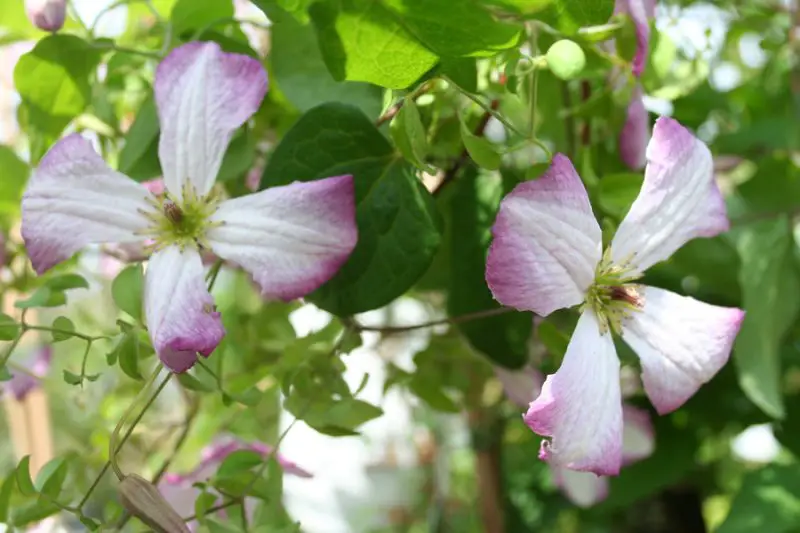
I Am Lady Q clematis is a romantic variety with beautifully shaped, rosy-pink flowers that exude elegance. The blooms are typically 4 to 6 inches wide, with a slightly deeper pink bar along the center of each petal and soft yellow stamens. This variety grows to about 6 to 8 feet tall, making it ideal for small trellises, obelisks, or container gardening. Its flowering season extends from late spring to early summer, often with a second lighter flush later in the season.
Identification is simple thanks to its soft rose-pink petals and slightly overlapping star shape, which give it a graceful and feminine appearance. The flowers maintain their color well and provide a lovely contrast against the deep green foliage. Its compact growth habit makes it a good choice for patios or smaller gardens.
For care, I Am Lady Q prefers fertile, well-draining soil with consistent moisture, especially during dry spells. It performs best in full sun to partial shade, with some shade during the hottest part of the day helping to preserve its flower color. As a Group 2 clematis, it requires light pruning after the first bloom and more thorough cutting back in late winter. It grows well in USDA hardiness zones 4 through 8.
Fujimusume
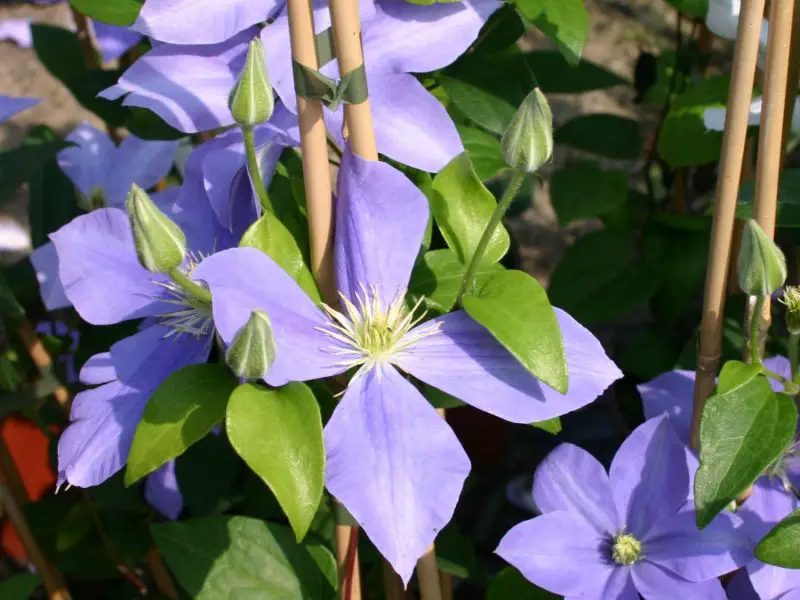
Fujimusume clematis is a traditional Japanese variety, prized for its stunning, large pale blue to lavender flowers. The blooms are 6 to 8 inches wide, featuring smooth, slightly rounded petals and prominent yellow stamens at the center. This elegant climber can reach 6 to 8 feet in height and flowers mainly in late spring to early summer, with a possible lighter second flush later in the season.
Identifying Fujimusume is easy due to its unique soft blue tones, which are rare among clematis varieties. The petals sometimes have a faintly textured surface, giving them a delicate, ethereal appearance. This variety is particularly valued for creating a cool, calming color palette in cottage or Japanese-inspired gardens.
For best results, plant Fujimusume in fertile, well-drained soil with regular watering to maintain even moisture. It prefers full sun to partial shade, with protection from intense afternoon sunlight helping preserve its pastel color. As a Group 2 clematis, light trimming after its first flowering encourages reblooming, while heavier pruning should be done in late winter. It thrives in USDA hardiness zones 4 through 8.
Arabella
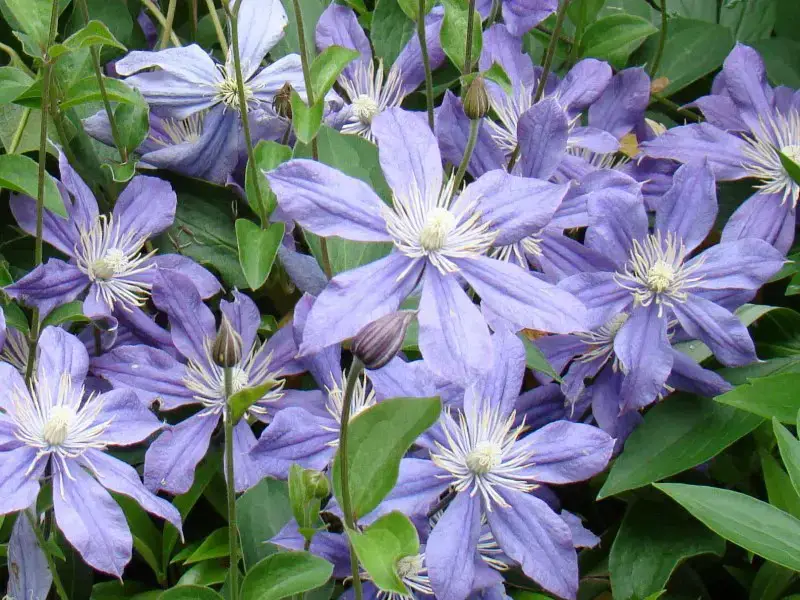
Arabella clematis is a versatile, non-climbing variety known for its continuous flowering and abundant blooms. Its flowers are 3 to 4 inches wide, with soft, mauve-blue petals that fade to a lighter blue as they age, creating a multi-tonal effect. Unlike most clematis, Arabella is herbaceous and tends to sprawl, making it ideal for growing through shrubs, as ground cover, or in containers. It blooms prolifically from early summer to early fall.
Identification is easy due to its profusion of small, star-shaped blooms that almost entirely cover the plant during peak flowering. The plant’s bushy, free-flowering habit and long bloom period make it perfect for filling gaps in borders or adding color to patio containers. Its soft tones also pair beautifully with roses and other flowering perennials.
Caring for Arabella is simple, as it thrives in fertile, well-drained soil and prefers consistent moisture to support its long blooming period. It grows best in full sun to partial shade and should be supported or tied loosely if used as a climber. Classified under Group 3 clematis, it benefits from being cut back to about 12 inches in late winter or early spring. Arabella grows well in USDA hardiness zones 4 through 9.
Abundance
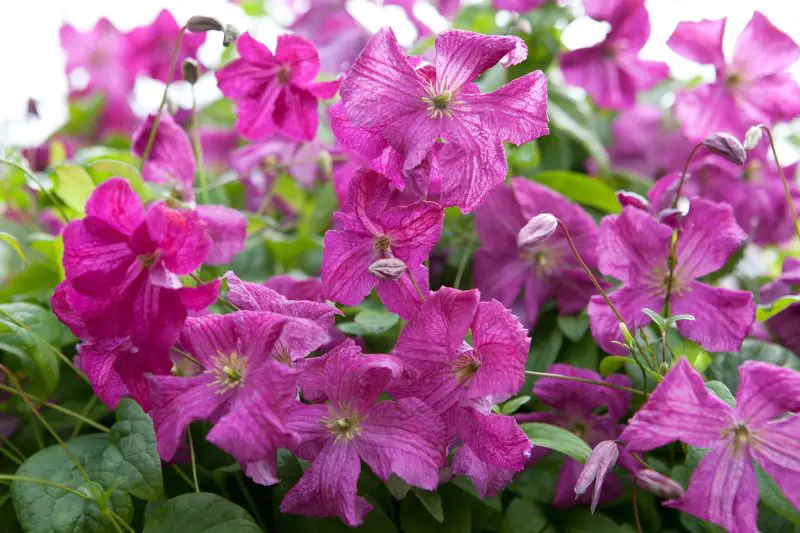
Abundance clematis is an aptly named variety, known for its profusion of small, starry flowers in shades of reddish-pink to crimson. The blooms measure 2 to 3 inches across and have slightly recurved petals with a satin-like sheen and creamy-yellow stamens. This vigorous climber reaches 10 to 15 feet in height and produces flowers in great numbers from mid-summer to early fall.
Identifying Abundance is easy due to its masses of small, reddish-pink flowers that cover the plant so densely that the foliage is often hidden during peak bloom. The slightly recurved petals give the flowers a delicate, airy look, making this variety ideal for adding a naturalistic touch to pergolas, archways, or scrambling through trees and shrubs.
For care, plant Abundance in fertile, well-draining soil with regular watering to keep the roots cool and moist. It thrives in full sun to partial shade and is particularly valued for its ability to cover large areas quickly. As a Group 3 clematis, it should be pruned back hard in late winter or early spring to encourage strong, vigorous growth. This variety performs well in USDA hardiness zones 4 through 9.
Hagley Hybrid
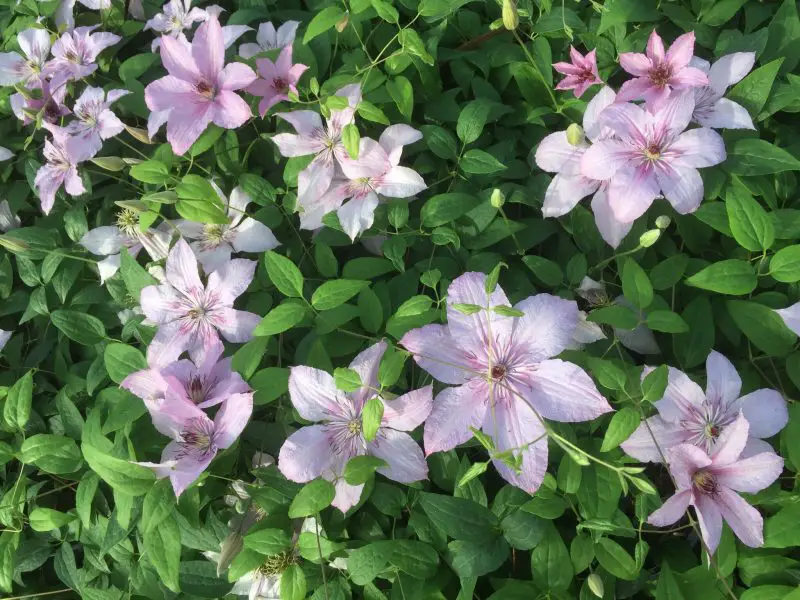
Hagley Hybrid clematis is a charming and reliable variety known for its dusty pink to soft mauve flowers with a delicate, pearly sheen. The blooms are typically 4 to 6 inches across, with slightly wavy edges and contrasting reddish-brown stamens. This medium-sized climber grows to about 6 to 8 feet tall, making it perfect for trellises, fences, or container gardening. It flowers from mid-summer to early fall, providing months of gentle color.
Identifying Hagley Hybrid is easy due to its unique soft pink petals that sometimes take on a silvery or shimmery appearance in sunlight. Its pastel tones blend beautifully with other flowering climbers or roses, making it a favorite for cottage-style gardens. The plant has a compact habit, making it well-suited for smaller spaces or patios.
Caring for Hagley Hybrid is straightforward. It thrives in fertile, well-drained soil and prefers full sun to partial shade. The blooms can fade in strong, direct sunlight, so providing afternoon shade in hot climates helps maintain their delicate color. As a Group 3 clematis, it benefits from hard pruning in late winter or early spring, cutting back to about 12 inches to encourage vigorous new growth. It performs best in USDA hardiness zones 4 through 9.
Madame Julia Correvon
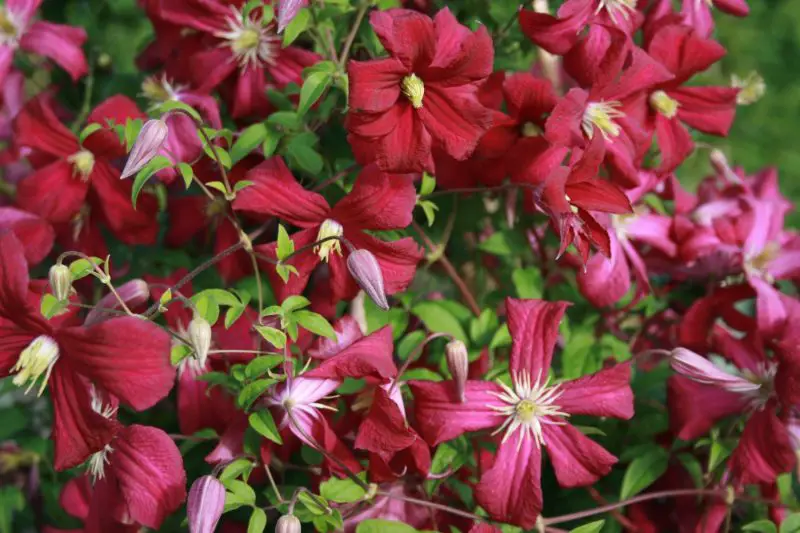
Madame Julia Correvon clematis is a vigorous, free-flowering variety admired for its striking, crimson-red blooms. The flowers are smaller, about 2 to 4 inches across, with slightly twisted, velvety petals and yellow stamens. It can grow up to 12 to 15 feet tall, making it ideal for covering pergolas, arches, and large trellises. Blooming from mid-summer to early fall, this variety provides a vibrant burst of color during the warm months.
Identification is simple thanks to its deep crimson-red flowers that stand out beautifully against its lush green foliage. The slightly twisted petals give it a unique, informal charm, making it suitable for naturalistic or cottage-style gardens. It pairs especially well with pale roses or light-colored clematis for striking color contrasts.
Madame Julia Correvon thrives in well-drained, fertile soil with regular watering to keep the soil evenly moist. It prefers full sun to partial shade, with full sun encouraging the richest flower color. As a Group 3 clematis, it should be pruned back hard to about 12 inches in late winter or early spring to stimulate vigorous flowering shoots. It grows best in USDA hardiness zones 4 through 9.
Doctor Ruppel
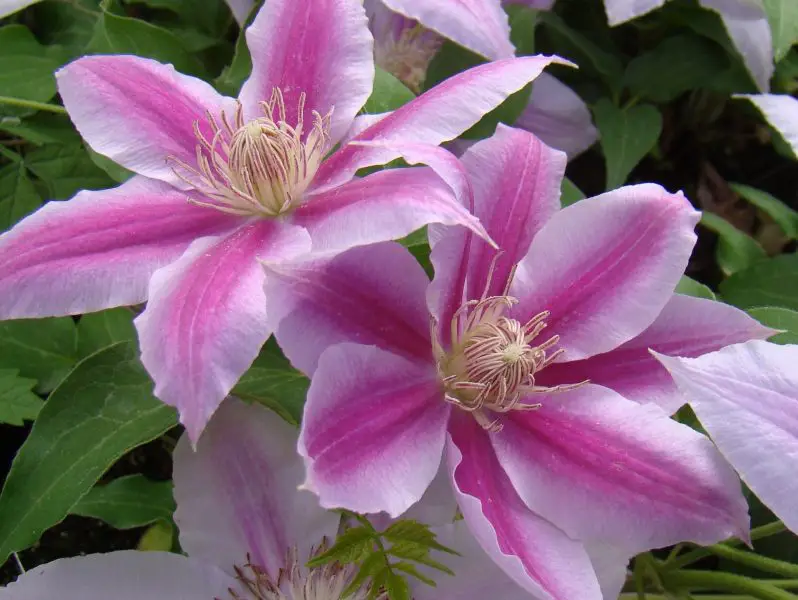
Doctor Ruppel clematis is a showy, large-flowered variety featuring pale pink petals with a bold, deep pink central stripe. Each bloom measures 6 to 8 inches wide, with slightly overlapping, rounded petals and contrasting yellow stamens. This variety grows 8 to 10 feet tall and blooms mainly in late spring to early summer, with a lighter second flush of flowers in late summer.
Identifying Doctor Ruppel is easy thanks to its striking two-tone petals, which make it a standout feature in any garden. The soft pink petals with their darker central bar create a dramatic yet elegant appearance. This clematis looks stunning climbing trellises, arbors, or fences and pairs beautifully with other pastel or white-flowering plants.
For care, plant Doctor Ruppel in fertile, well-drained soil with consistent moisture. It prefers full sun to partial shade, though some afternoon shade in hotter climates helps preserve the intensity of its pink coloring. Following Group 2 clematis pruning, light trimming after the first bloom encourages reblooming, while more substantial pruning should be done in late winter. It thrives in USDA hardiness zones 4 through 8.
Crystal Fountain
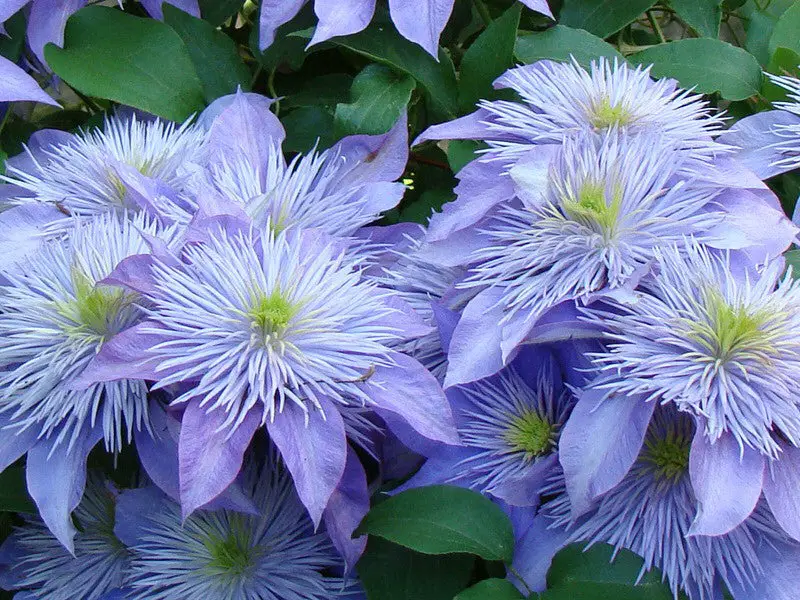
Crystal Fountain clematis, also known as Fair Rosamond, is a spectacular variety with fully double, semi-rosette blooms. The flowers are 4 to 6 inches across, featuring lavender-blue petals with a striking spiky center of silvery-blue petaloid stamens, giving them a “fountain” effect. This compact climber grows to about 6 to 8 feet tall and blooms from late spring to early summer, often repeating in late summer.
Identifying Crystal Fountain is simple because of its distinctive, multi-layered flowers with a spiky central boss, unlike most other clematis. The unique flower structure adds texture and depth, making it a perfect choice for adding visual interest to patios, small trellises, or containers. Its soft blue tones also create a soothing, elegant garden display.
Crystal Fountain thrives in fertile, well-drained soil with consistent watering to maintain healthy growth. It prefers full sun to partial shade, with some protection from intense afternoon sunlight helping to preserve its pastel colors. As a Group 2 clematis, it benefits from light pruning after the first flowering and a harder cutback in late winter. It grows best in USDA hardiness zones 4 through 9.
Piilu
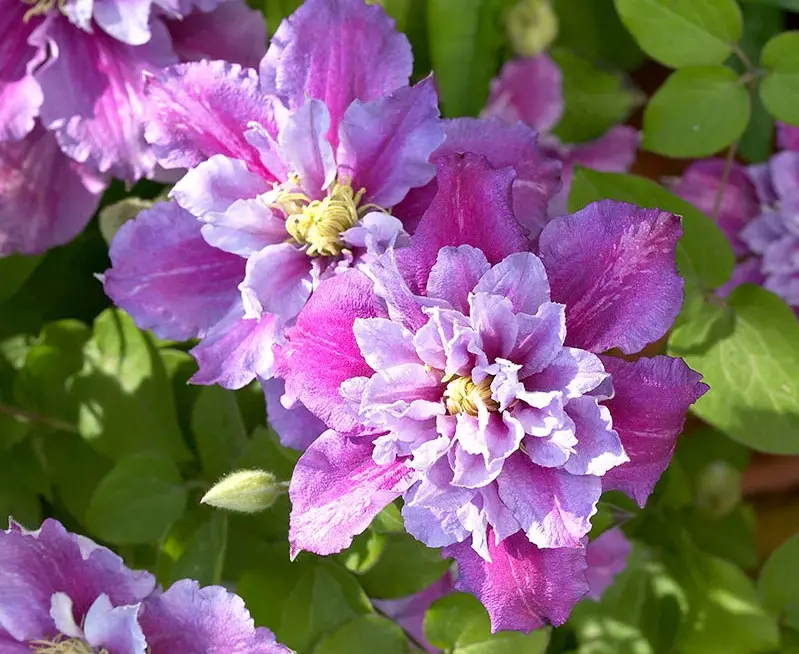
Piilu clematis is a compact and prolific variety, producing both single and double flowers on the same plant. Early-season blooms are often fully double, with layers of soft pink petals and a deeper pink stripe, while later blooms are single but equally charming. The flowers are 3 to 5 inches wide, and the plant grows to about 4 to 6 feet tall, making it ideal for containers, small trellises, or patio gardens. It flowers heavily from late spring through early fall.
Identification of Piilu is easy due to its unique flowering habit, with its early-season rosette-like double flowers transitioning to simpler single blooms. Its compact size and free-flowering nature make it perfect for smaller spaces or balcony gardens, and its soft pink coloring pairs beautifully with white or pale blue clematis.
Caring for Piilu is simple, as it thrives in fertile, well-draining soil and benefits from consistent moisture. It prefers full sun to partial shade, with some shade recommended in hot climates to keep the blooms fresh and vibrant. Following Group 2 pruning, light trimming after its first flush helps promote additional flowering, while a harder cutback in late winter encourages healthy new growth. It grows well in USDA hardiness zones 4 through 9.
Carnaby
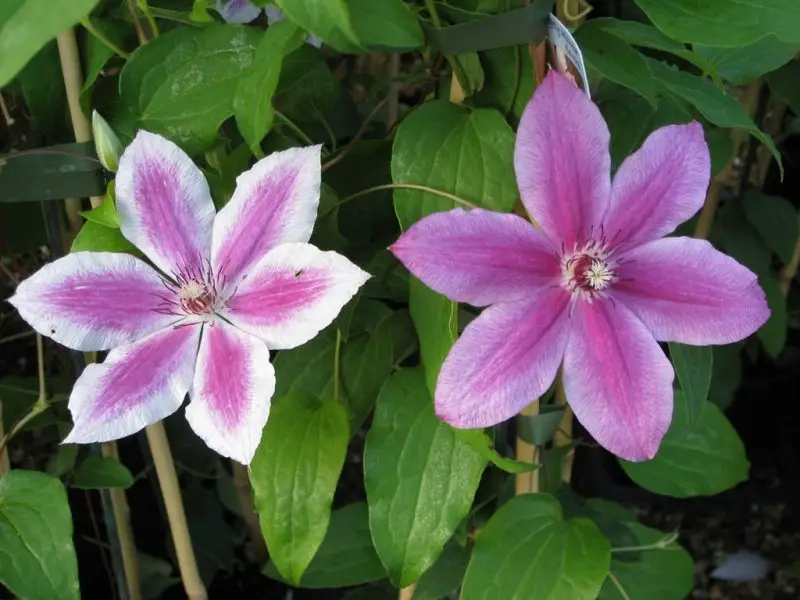
Carnaby clematis is a striking variety admired for its bold two-tone flowers. The blooms are 6 to 8 inches wide, with pale pink petals accented by a vivid deep pink stripe running through the center of each petal, complemented by creamy-yellow stamens. This medium-sized climber typically grows 6 to 8 feet tall and flowers mainly in late spring to early summer, with a lighter second flush in late summer or early fall.
Identification of Carnaby is straightforward thanks to its vibrant striped petals, which provide a cheerful and eye-catching display. The blooms have a slightly rounded, overlapping shape, giving them a full and symmetrical appearance. It is particularly attractive on garden trellises, fences, or in containers, where its bright coloring stands out against green foliage.
For care, plant Carnaby in fertile, well-draining soil with consistent moisture to encourage healthy growth and abundant flowering. It thrives in full sun to partial shade, with some protection from harsh afternoon sun helping maintain its vivid flower color. As a Group 2 clematis, light pruning after the first bloom encourages reblooming, while harder pruning in late winter refreshes the plant for the following season. It grows well in USDA hardiness zones 4 through 8.
Yamato
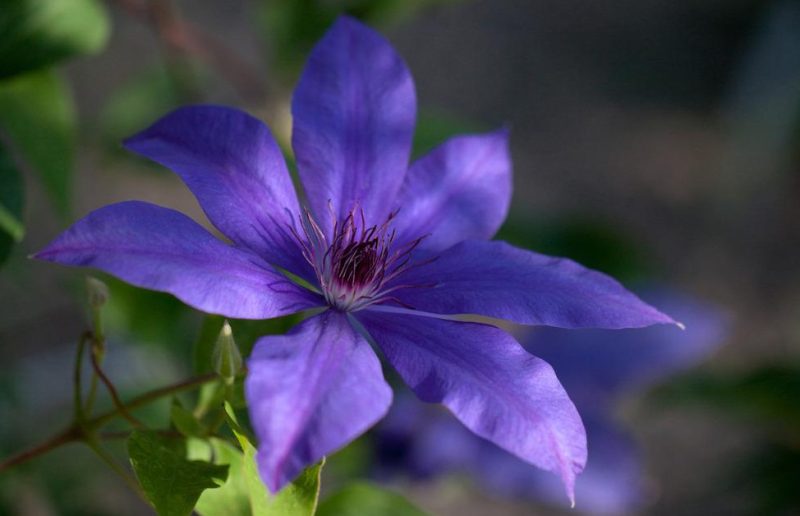
Yamato clematis is a Japanese variety prized for its rich, deep red-purple flowers with a velvety texture. The blooms are typically 5 to 7 inches wide, with slightly ruffled petals and contrasting golden-yellow stamens. This elegant climber grows 6 to 8 feet tall and blooms in late spring to early summer, often with a second flush in late summer, making it a long-season performer.
Identifying Yamato is easy due to its intense wine-red coloring and velvety petal texture, which create a luxurious effect in the garden. The blooms hold their color well, even in bright sunlight, making them ideal for sunny borders, pergolas, or fences. Its compact size also makes it suitable for smaller gardens and container growing.
Yamato thrives in fertile, well-drained soil enriched with organic matter and requires regular watering to maintain soil moisture. It prefers full sun to partial shade, with full sun encouraging deeper flower color. As a Group 2 clematis, it should be pruned lightly after the first bloom and more thoroughly in late winter. It performs best in USDA hardiness zones 4 through 9.
Rouge Cardinal
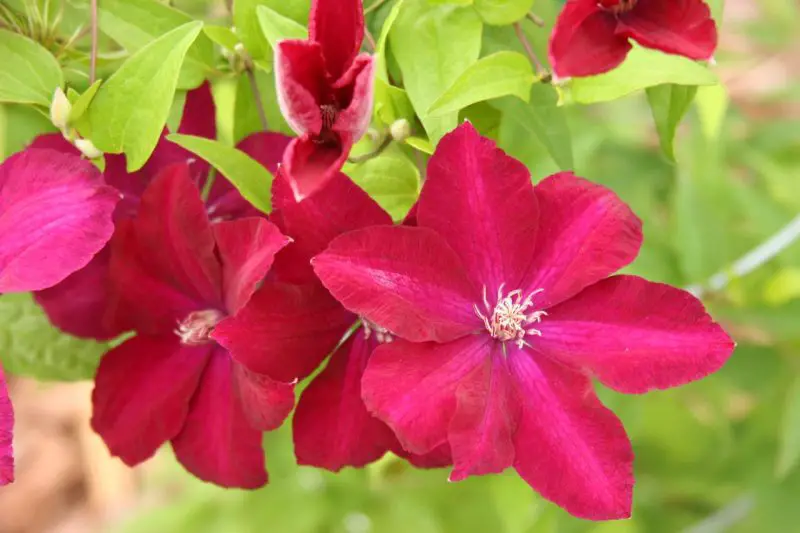
Rouge Cardinal clematis is a classic, award-winning variety known for its velvety, crimson-red flowers. The blooms are 4 to 6 inches wide, with slightly overlapping petals and striking golden stamens, creating a vivid contrast. This vigorous climber can reach 8 to 10 feet tall and produces flowers abundantly from mid-summer to early fall.
Identification of Rouge Cardinal is simple thanks to its rich crimson coloring, which remains vibrant even in full sunlight. The velvety petals give the flowers a luxurious texture, making them ideal for creating dramatic vertical displays on trellises, fences, or pergolas. It pairs beautifully with pale or white clematis for a bold color combination.
Caring for Rouge Cardinal involves planting it in fertile, well-drained soil with consistent watering to keep the roots cool and moist. It thrives in full sun to partial shade, with some afternoon shade beneficial in very hot climates. As a Group 3 clematis, it requires hard pruning in late winter or early spring, cutting back to about 12 inches to promote vigorous new flowering stems. It grows best in USDA hardiness zones 4 through 9.
Ernest Markham
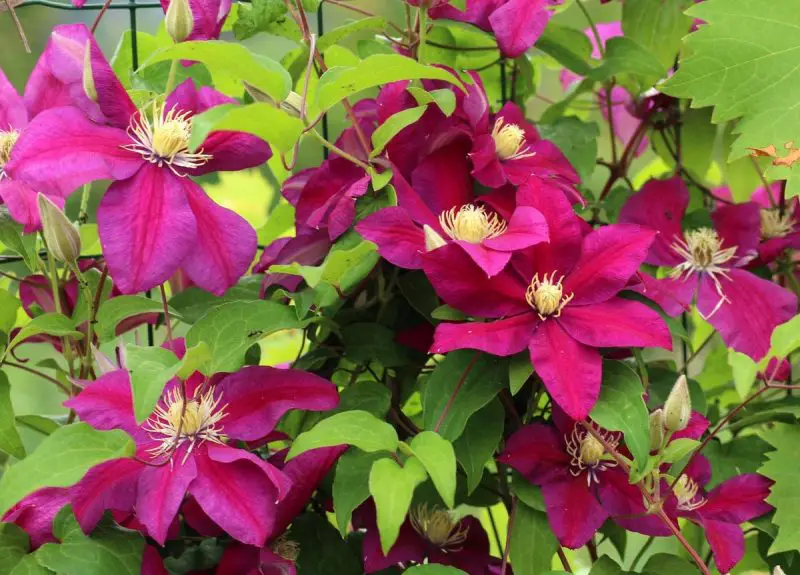
Ernest Markham clematis is a vibrant, fast-growing variety with large, magenta-red flowers. The blooms are 5 to 6 inches wide, with velvety petals and creamy-yellow stamens that add a striking contrast. This vigorous climber can grow up to 10 to 12 feet tall and flowers abundantly from mid-summer to early fall, making it an excellent choice for long-lasting garden color.
Identification is easy due to its vivid magenta-red coloring, which brightens any vertical surface. The velvety texture of the petals and slightly overlapping star-shaped flowers give it a rich, elegant appearance. Ernest Markham is particularly effective when grown on fences, pergolas, or even scrambling through shrubs and small trees.
For care, plant Ernest Markham in well-drained, fertile soil with regular watering, especially during dry periods. It thrives in full sun to partial shade, with full sun encouraging the deepest flower color. This Group 3 clematis benefits from hard pruning in late winter or early spring to encourage strong new growth and abundant flowering. It grows well in USDA hardiness zones 4 through 9.
Maria Therese
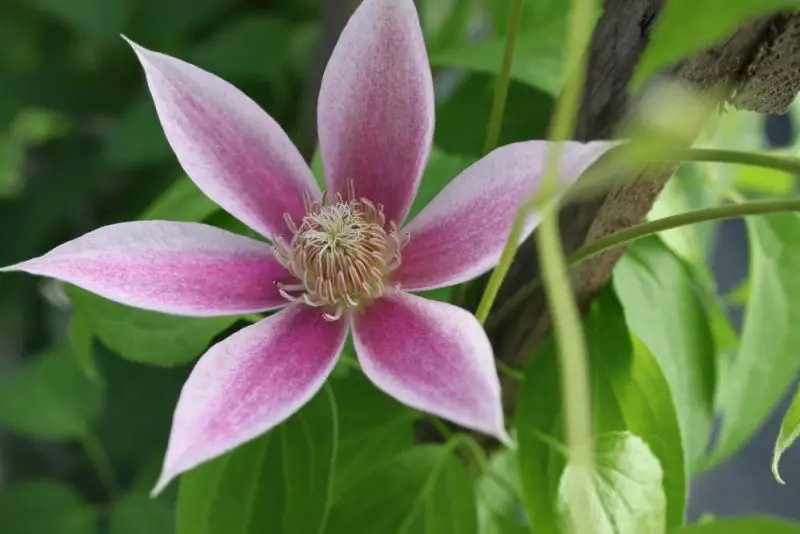
Maria Therese clematis is a soft and romantic variety, admired for its pale pink to lavender-pink blooms. The flowers are 4 to 6 inches across, with slightly overlapping petals and creamy-yellow stamens, giving them a delicate, graceful appearance. This compact climber grows to about 5 to 7 feet tall and flowers profusely from late spring to early fall.
Identifying Maria Therese is simple due to its soft pastel coloring, which provides a gentle, calming effect in the garden. The blooms hold their color well in partial shade, making this clematis perfect for cottage gardens, patios, or containers. Its compact habit also makes it suitable for smaller spaces.
Caring for Maria Therese is easy, as it thrives in fertile, well-drained soil and requires consistent watering to keep the roots cool and healthy. It prefers full sun to partial shade, with some shade in hotter climates helping preserve its delicate flower color. Following Group 3 clematis pruning, it should be cut back hard in late winter or early spring to promote strong new shoots and prolific flowering. This variety performs well in USDA hardiness zones 4 through 9.
Vyvyan Pennell
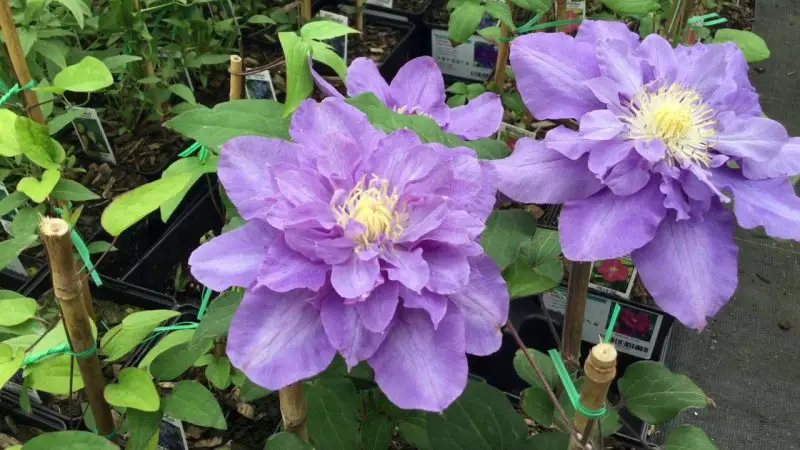
Vyvyan Pennell clematis is an elegant double-flowered variety, producing large, layered blooms in a rich violet-blue hue. The flowers are 6 to 8 inches wide, with outer petals forming a star shape and a dense, frilled central rosette, giving them a luxurious appearance. In late spring to early summer, the plant produces double flowers, while a second flush in late summer usually features single but equally striking blooms. This climber grows 8 to 10 feet tall, making it ideal for trellises, fences, and arbors.
Identifying Vyvyan Pennell is simple due to its full, multi-layered flowers with a deep violet hue that sometimes appears tinged with purple-red in strong sunlight. Its rich color and large double blooms create a dramatic focal point, making it a favorite for cottage gardens and formal landscapes alike.
Caring for Vyvyan Pennell involves planting in fertile, well-drained soil with consistent moisture to support its heavy flowering. It thrives in full sun to partial shade, though some protection from harsh afternoon sunlight helps maintain its vivid coloring. As a Group 2 clematis, it benefits from light pruning after the first flush and more thorough cutting back in late winter. It performs best in USDA hardiness zones 4 through 8.
Gipsy Queen
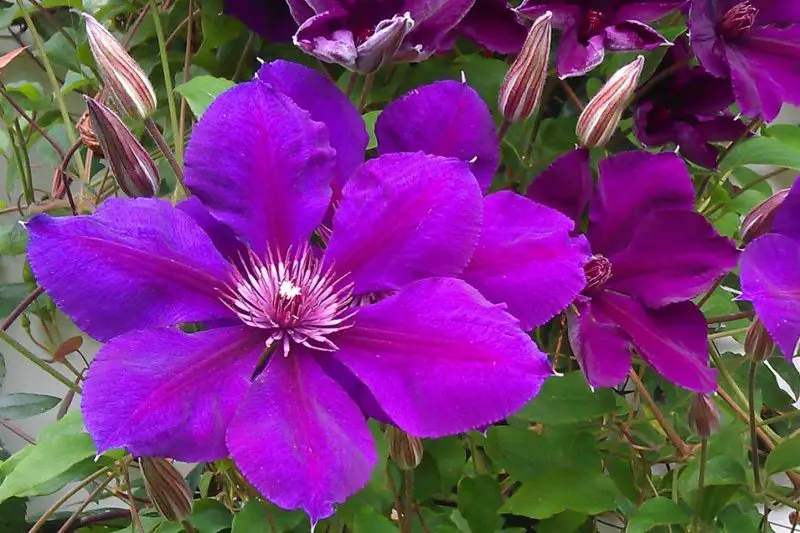
Gipsy Queen clematis is a classic, vigorous variety celebrated for its rich, velvety purple flowers. The blooms are 4 to 6 inches wide, with slightly overlapping petals and golden stamens, creating a striking contrast. Flowering from mid-summer to early fall, this variety grows 8 to 12 feet tall, making it perfect for covering fences, trellises, and walls.
Identification is easy thanks to its deep, reddish-purple petals, which appear almost velvety and retain their rich color even in strong sunlight. Its abundant blooms make it a reliable choice for gardeners seeking long-lasting color, and it pairs beautifully with pale pink or white clematis for a vibrant contrast.
For best care, plant Gipsy Queen in well-drained, fertile soil with regular watering to maintain consistent moisture. It thrives in full sun to partial shade, although full sun helps bring out the deepest flower color. As a Group 3 clematis, it requires hard pruning in late winter or early spring, cutting back to about 12 inches to encourage vigorous new flowering shoots. It grows well in USDA hardiness zones 4 through 9.
Samaritan Jo
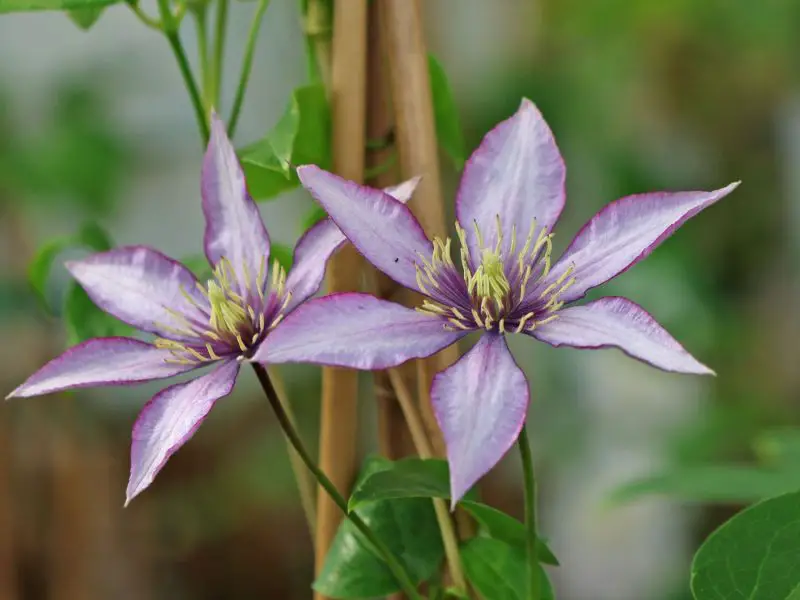
Samaritan Jo clematis is a unique and modern variety, admired for its star-shaped silvery-lavender blooms. The flowers are 4 to 6 inches wide, with pointed petals edged in soft pink and a striking red-purple central bar, complemented by creamy-yellow stamens. This compact climber grows 4 to 6 feet tall, making it perfect for containers, patios, and smaller garden spaces. It blooms profusely from late spring to early fall.
Identifying Samaritan Jo is easy due to its distinctive silvery-lavender petals and sharp, star-like shape. The delicate color shifts with sunlight, sometimes appearing more pinkish or lavender depending on the time of day. Its compact habit and long blooming season make it a great choice for decorative pots or small trellises.
Caring for Samaritan Jo involves planting in well-drained, fertile soil with consistent moisture to encourage flowering. It thrives in full sun to partial shade, with some shade during hot afternoons helping preserve its delicate coloring. As a Group 2 clematis, it requires light pruning after the first flush of flowers and a harder cutback in late winter. It grows best in USDA hardiness zones 4 through 9.
Alpine
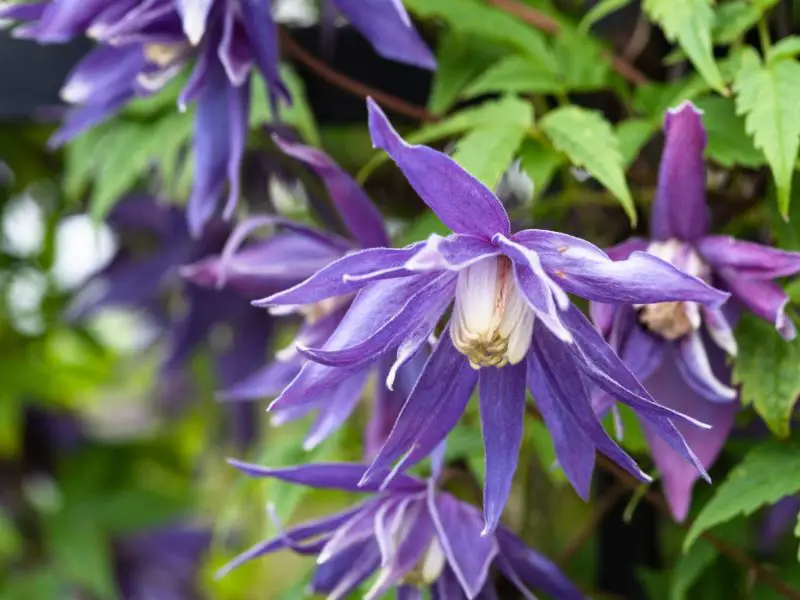
Alpine clematis, also known as Clematis alpina, is an early-flowering species variety prized for its nodding, bell-shaped flowers. The blooms are usually 1 to 3 inches wide, with four narrow, petal-like sepals in shades of blue, purple, or sometimes pink, surrounding creamy stamens. It is a vigorous, hardy climber reaching 8 to 12 feet tall, flowering abundantly in mid to late spring, often before many other clematis varieties start blooming.
Identification of Alpine clematis is simple due to its dainty, nodding bell-like flowers and delicate, finely divided green foliage. Its naturalistic and woodland charm makes it ideal for scrambling through shrubs, climbing small trees, or softening fences in cottage or wild gardens.
Alpine clematis thrives in well-drained, moderately fertile soil and prefers full sun to partial shade. It is a low-maintenance plant, requiring minimal pruning as it belongs to Group 1 clematis—only light trimming after flowering is necessary. It performs well in colder regions and is highly hardy, growing best in USDA hardiness zones 3 through 9.
H. F. Young
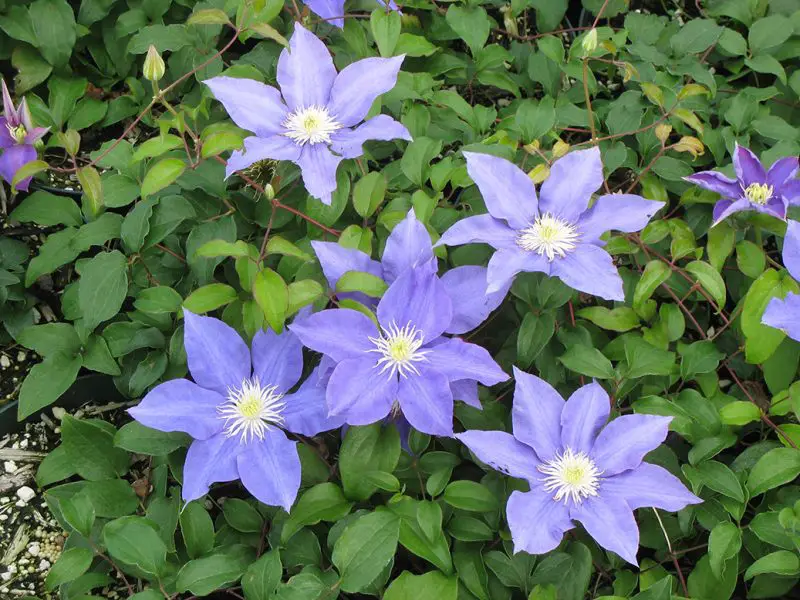
H. F. Young clematis is a classic large-flowered variety known for its stunning sky-blue to lavender-blue blooms. The flowers are 6 to 8 inches wide, with broad, overlapping petals and creamy-yellow stamens, creating a refined and elegant display. This vigorous climber reaches 8 to 10 feet tall and flowers profusely in late spring to early summer, with a lighter second flush often appearing in late summer.
Identifying H. F. Young is easy due to its distinctive soft blue coloring, which brightens sunny walls, trellises, or arbors. The large, star-shaped blooms stand out beautifully against green foliage, making it a favorite for both traditional and modern garden designs.
Caring for H. F. Young involves planting in fertile, well-drained soil with consistent moisture to encourage strong growth. It thrives in full sun to partial shade, with protection from intense afternoon sunlight helping maintain its delicate blue coloring. As a Group 2 clematis, it requires light pruning after the first flowering and more thorough cutting back in late winter to encourage new shoots. It grows best in USDA hardiness zones 4 through 8.
Hairy
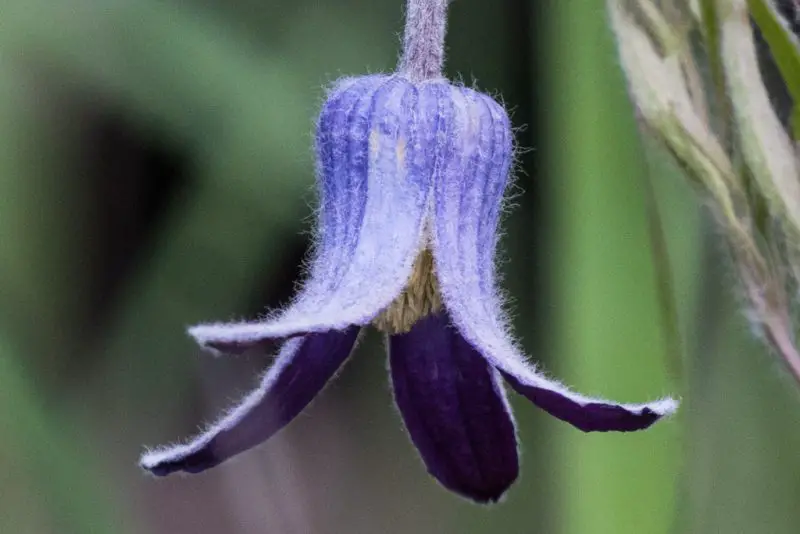
Hairy clematis, also known as Clematis heracleifolia var. davidiana, is a bush-type clematis valued for its clusters of small, tubular, violet-blue flowers. Each bloom is about 1 to 2 inches long and emits a sweet fragrance, attracting pollinators such as bees and butterflies. This non-climbing variety grows 2 to 4 feet tall and blooms from mid to late summer, offering long-lasting color in garden borders.
Identification is easy due to its unusual upright, shrub-like habit and whorls of hairy, lance-shaped green leaves, which give the plant its common name. The small, fragrant, bell-shaped flowers are produced in clusters, making it a unique addition to perennial borders or cottage gardens.
Caring for Hairy clematis is simple. It thrives in fertile, well-drained soil and prefers full sun to partial shade. Regular watering is important, especially during dry periods, to support its summer blooming. As a Group 3 clematis, it benefits from hard pruning in late winter or early spring to encourage new, strong shoots. This hardy plant grows best in USDA hardiness zones 4 through 8.
Solitary
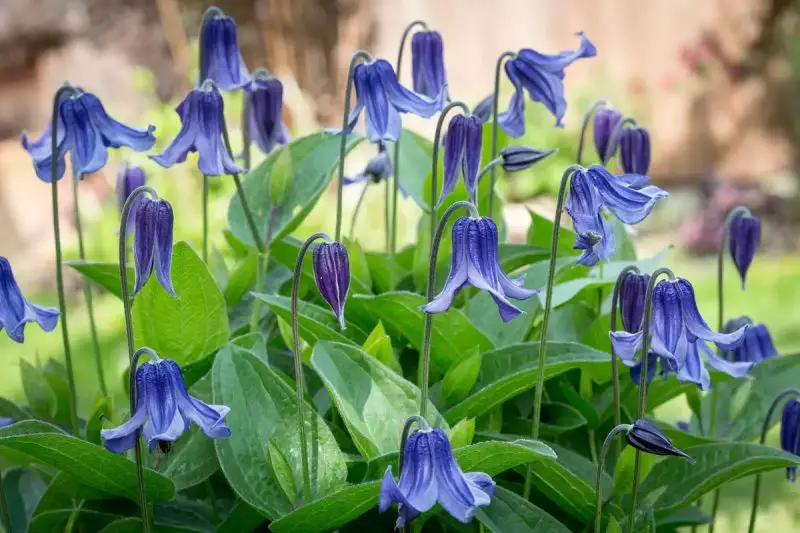
Solitary clematis, often referring to Clematis integrifolia, is a charming herbaceous variety that forms a small, bushy clump rather than climbing. Its nodding, bell-shaped flowers are 1 to 2 inches wide, appearing in shades of deep blue to violet, with slightly twisted petals and yellow stamens. It blooms from early to mid-summer, reaching a mature height of 2 to 3 feet, making it perfect for borders and rock gardens.
Identification is easy due to its compact, upright growth habit and distinctive solitary blooms that face downward, giving it a natural, woodland charm. The plant also produces attractive fluffy seed heads in late summer, adding ornamental interest after flowering.
Caring for Solitary clematis is straightforward, as it prefers fertile, well-drained soil with consistent moisture. It grows best in full sun to partial shade, with full sun encouraging richer flower color. Classified under Group 3, it should be cut back hard in late winter or early spring to encourage vigorous growth. This hardy species grows well in USDA hardiness zones 3 through 8.
Westerplatte
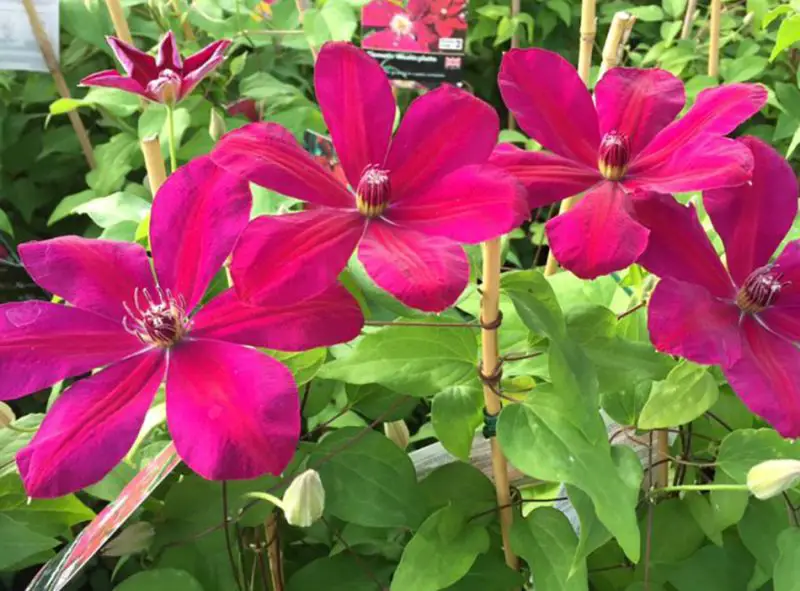
Westerplatte clematis is a compact, free-flowering variety known for its striking, velvety crimson-red blooms. The flowers are 4 to 6 inches wide, with slightly overlapping petals and bright yellow stamens, creating a vivid contrast. Blooming from late spring through early fall, this clematis reaches 4 to 6 feet tall, making it ideal for containers, patios, or small trellises.
Identifying Westerplatte is easy due to its intense, deep red color, which remains vibrant even in full sun. The slightly rounded petals give the flowers a soft yet bold appearance, making them a perfect choice for adding dramatic color to small garden spaces.
For best growth, plant Westerplatte in fertile, well-drained soil with regular watering to keep the soil moist but not waterlogged. It thrives in full sun to partial shade, with some shade in very hot climates helping to maintain its rich color. As a Group 2 clematis, it requires light pruning after the first flush of flowers and more thorough pruning in late winter. It grows well in USDA hardiness zones 4 through 9.
Mrs. Yuki
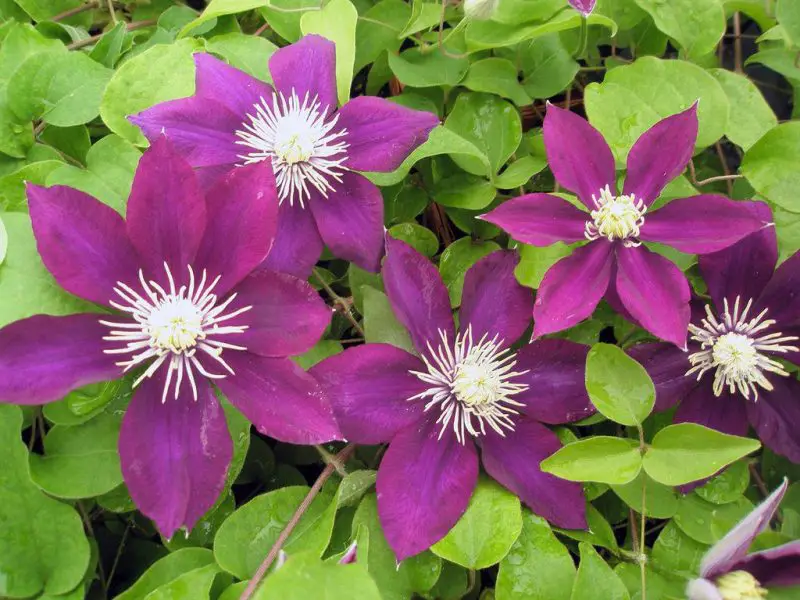
Mrs. Yuki clematis is a delicate and elegant variety, producing pure white, star-shaped flowers with a subtle creamy sheen. Each bloom measures 4 to 6 inches wide, with slightly pointed petals and soft yellow stamens, giving it a refined, clean appearance. This compact climber grows to about 5 to 7 feet tall and blooms heavily from late spring to early summer, often repeating in late summer.
Identification of Mrs. Yuki is simple thanks to its pristine white flowers, which stand out beautifully against dark green foliage. Its neat, compact growth habit makes it perfect for small trellises, patios, or container gardening, and it pairs well with darker clematis varieties for contrast.
Caring for Mrs. Yuki involves planting it in fertile, well-draining soil with consistent watering, especially during dry periods. It thrives in full sun to partial shade, with some shade during the hottest part of the day helping keep the white petals fresh and unscorched. As a Group 2 clematis, it benefits from light pruning after the first bloom and harder pruning in late winter. It grows best in USDA hardiness zones 4 through 8.
Abilene
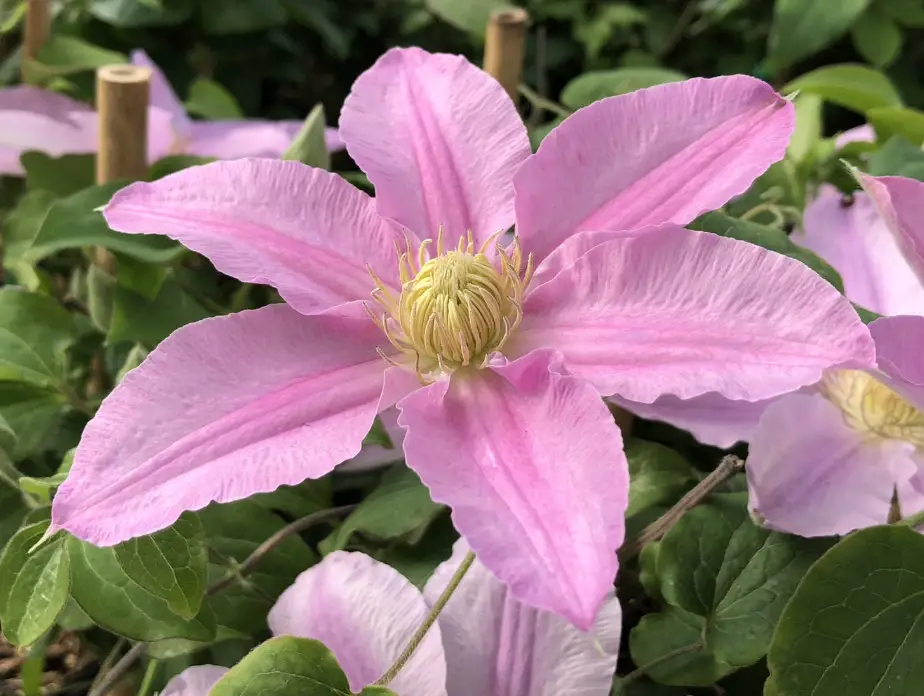
Abilene clematis is a compact and charming variety known for its pinkish-mauve flowers with a deeper pink stripe running down the center of each petal. The blooms are 4 to 6 inches wide, with rounded petals and contrasting creamy stamens. It flowers prolifically from late spring through early fall and typically grows 4 to 6 feet tall, making it an excellent choice for containers, balconies, and small garden trellises.
Identification is easy due to its soft pink coloring with a pronounced central bar and its compact growth habit, which makes it perfect for decorative pots or small spaces. The long blooming season ensures months of continuous color, even in limited garden areas.
Caring for Abilene is simple, as it thrives in fertile, well-drained soil and requires regular watering to support its long flowering period. It grows best in full sun to partial shade, with some afternoon shade in hot regions preserving the vibrancy of its petals. Following Group 2 pruning, light trimming after the first flush of blooms encourages further flowering, while a harder cutback should be done in late winter. It performs well in USDA hardiness zones 4 through 9.
FAQs About Types of Clematis Plants
Which Clematis Types Are Best for Beginners?
Compact and hardy varieties, such as Westerplatte, Hagley Hybrid, and Arabella, are great choices for beginners. These clematis are easy to grow, have long blooming periods, and require minimal maintenance. Herbaceous types like Arabella are also easier to manage because they don’t need extensive support structures.
What Are the Most Popular Clematis Varieties?
Some of the most popular clematis varieties include Nelly Moser, Jackmanii, Rouge Cardinal, Ernest Markham, and Vyvyan Pennell. These are widely grown for their large, colorful flowers and reliable blooming performance. Many gardeners also love unique varieties such as Crystal Fountain and Josephine for their unusual double or spiky blooms.
Which Clematis Types Are Best for Containers?
Compact clematis varieties, such as Abilene, Piilu, Samaritan Jo, and Mrs. Yuki, are ideal for containers. These plants grow to a manageable height, typically between 4 and 7 feet, making them suitable for patios and balconies. Container-grown clematis should be watered regularly and given support, such as a small trellis or obelisk.
What Clematis Types Are Best for Shady Spots?
Some clematis thrive in partial shade, such as Nelly Moser, Vyvyan Pennell, and Mrs. Yuki. Light-colored blooms, especially whites and pastels, tend to show up well in shaded areas, brightening darker garden corners. However, even shade-tolerant clematis perform better with at least 4 to 6 hours of indirect sunlight daily.
Which Clematis Types Bloom the Longest?
Varieties like Arabella, Abilene, and Ernest Markham are known for their extended blooming periods. Arabella, in particular, can bloom continuously from early summer to early fall. Choosing remontant (repeat-blooming) clematis, especially Group 2 and some Group 3 types, ensures flowers for a longer season.
What Are the Hardiest Clematis Types for Cold Climates?
Early-flowering species, such as Alpine (Clematis alpina) and Hairy clematis (Clematis heracleifolia), are among the hardiest types, thriving in USDA zones as low as 3. Montana varieties are also cold-tolerant but require space to grow vigorously. Many Group 3 clematis, like Jackmanii and Gipsy Queen, are hardy and survive harsh winters well when properly mulched.
Which Clematis Types Have Fragrant Flowers?
While most clematis are not heavily scented, some species, like Hairy clematis (Clematis heracleifolia) and Sweet Autumn clematis (Clematis terniflora), are known for their pleasant fragrance. These are excellent choices for planting near patios or seating areas where the scent can be enjoyed up close.
What Types of Clematis Are Best for Fast Coverage?
Vigorous climbers like Ernest Markham, Rouge Cardinal, Ville de Lyon, and Montana varieties are excellent for covering fences, walls, and pergolas quickly. These types can grow over 10 feet tall in a single season, creating a lush, colorful display.






